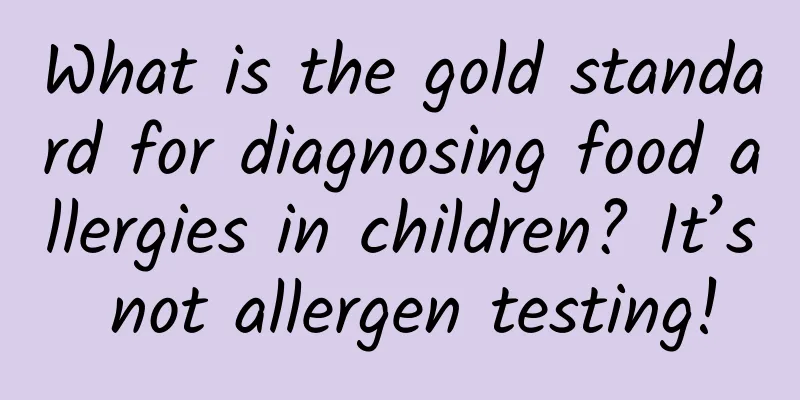What is the gold standard for diagnosing food allergies in children? It’s not allergen testing!

|
Author: Wu Jie, Chief Physician, National Children's Medical Center, Beijing Children's Hospital, Capital Medical University Reviewer: Yang Yunsheng, Chief Physician, PLA General Hospital In recent years, people have paid more and more attention to food allergies. Food allergies can cause mild or severe symptoms in multiple systems, such as the gastrointestinal tract, skin mucosa, respiratory tract, etc. Severe cases can cause anaphylactic shock and threaten life. The prevalence of food allergies has gradually increased, becoming one of the main problems threatening children's health. For food allergies, the first step is to make a clear diagnosis of whether it is a food allergy and what kind of food you are allergic to before you can proceed to the next step of treatment. 1. Is food allergy in children easy to diagnose? There is no very effective diagnostic method for children's food allergies, so it is very important for parents to provide a detailed medical history. For example, when asking about the medical history, if it is found that the child's parents have a history of food allergies, and the child has multiple system involvement, such as skin, respiratory, and digestive system symptoms after contact with a certain food, then the diagnosis of food allergy is more likely. The next step can be combined with laboratory tests, such as routine blood tests to see if the eosinophil count is high; allergen testing and other auxiliary diagnosis. The only gold standard for diagnosing food allergies is the food avoidance provocation test. Simply put, it is to avoid a suspected allergenic food for 2-4 weeks. After the symptoms are significantly improved, further provocation tests are needed to reintroduce the food. If the same symptoms occur after eating, food allergies can be diagnosed. Figure 1 Original copyright image, no permission to reprint Diagnosing food allergies is a relatively complex and professional process, and requires going to the hospital to be diagnosed by a specialist. 2. Can allergen testing accurately identify which food a child is allergic to? Currently, there are two methods for allergen detection: one is blood drawing, and the other is skin prick test. Figure 2 Original copyright image, no permission to reprint Drawing blood for allergen testing only tests for IgE-mediated allergic reactions. For example, if an immediate allergic reaction occurs within two hours of eating a certain food, this can be detected by current allergen testing. Allergen test results need to be evaluated by a professional doctor. A positive result does not mean that you are allergic to the food. It only means that you may be allergic to the food. You may or may not be allergic in the future. A negative allergen test result does not mean that you are not allergic. It may be related to the short time of contact with the allergic food, and not enough antibodies have been produced, or it may be a non-IgE-mediated allergic reaction that cannot be detected. Allergen testing is only an auxiliary examination method that can help us determine which food we may be allergic to. However, it is difficult to determine whether we are allergic to a specific food based on allergen testing alone, and a comprehensive judgment is required. 3. What should I do if my child is allergic to food? Food allergies require comprehensive treatment. First of all, allergic foods must be strictly avoided. For example, if a child is found to be allergic to eggs, eggs and foods containing egg ingredients must be avoided for a period of time. If a breastfed child is clearly allergic to milk, the mother should strictly avoid dairy products. After avoiding them, the child's symptoms may be controlled. If the mother strictly abstains from dairy products for 4-6 weeks and the child's symptoms continue to appear and do not improve, and the child's growth and development are delayed, it may be recommended to stop breastfeeding and switch to artificial feeding. For children who are fed with milk powder and are clearly allergic to milk powder, they should choose low-allergy formula milk powder, including deep hydrolyzed protein formula milk powder and amino acid formula milk powder. According to the severity of the child's allergy, the doctor will help choose which formula milk powder is more suitable. It is generally recommended to eat low-allergy formula milk powder for at least half a year, or when the child reaches 9-12 months old and may have tolerated milk protein, it is recommended to go to the hospital for a doctor to determine whether it can be replaced with ordinary milk powder. The first thing to do with food allergies is to avoid the food you are allergic to. If the symptoms are significantly relieved after avoiding them, there is no need to do anything else. If the symptoms are not relieved, continue to appear, or even get worse, choose appropriate medications based on the symptoms. For example, for particularly severe eczema, apply some topical medications; for acute urticaria, take oral antihistamines; for gastrointestinal symptoms, such as nausea, vomiting, or diarrhea, use antidiarrheal drugs, probiotics, digestive enzyme preparations, etc. Children with food allergies need to be followed up and re-examined on time, because they are particularly prone to malnutrition, growth retardation and other problems. The doctor will judge whether the low-allergy formula milk powder is appropriate, whether the complementary food is appropriate, whether the growth and development is normal, and correct any problems as soon as they are found. In addition, the doctor will also take some measures, such as adding complementary food in time and taking oral probiotic preparations, which will help to establish oral tolerance early and make the child no longer allergic to food faster. As children grow and develop, their immune systems gradually mature and they will develop a natural immune tolerance to food. As they grow older, food allergies tend to heal on their own. For example, for milk protein allergies, 45%-50% of children may no longer be allergic by the age of one; only 20% of children may still be allergic by the age of three or four; and only 10% of children over the age of six may be allergic. Of course, some foods, such as peanuts, may not be eaten for life. |
>>: Is diarrhea a major cause of death among children? Keep these four medicines at home!
Recommend
Can I practice yoga during menstruation?
Adult women have menstruation every month. Many w...
"Staying up late" not only affects your physical health, but may also be the culprit of hair loss!
Have you ever lost a lot of hair due to staying u...
World Sleep Day | Healthy sleep for everyone
World Sleep Day | Healthy sleep for everyone Tong...
What are the symptoms of fallopian tube tuberculosis
Fallopian tube tuberculosis is a common disease a...
[The trouble caused by high heels] Only your feet know~~
What do "high heels" mean to women? Bea...
What are the benefits of eating meat floss? How to choose meat floss
Meat floss is a dehydrated product made by boilin...
Introduction to the treatment of candidiasis vaginitis
I believe that many female friends are particular...
Reasons for a week late menstruation
Menstruation is a physiological phenomenon unique...
What should I do if I have a headache or dizziness? These methods are more effective than medication
When it comes to dizziness and headaches, many pe...
Is microwave treatment good for cervical erosion?
There are several treatments for cervical erosion...
Can pregnant women eat egg rolls?
Egg rolls are a snack that was introduced to Chin...
What to do if a pregnant woman has a heat stroke and headache
In the hot summer, many people will suffer from s...
What does the word "jinji" mean on the chess board? What is the name of the river in chess?
In Chinese chess, as the saying goes, the horse m...
Which sanitary napkin is of good quality?
Sanitary napkins are an item used by all women, a...
Can I eat yogurt during my period?
Women's diet during menstruation should be li...









